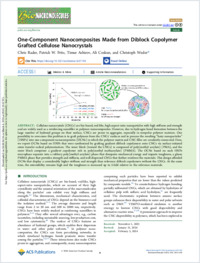One-Component Nanocomposites Made from Diblock Copolymer Grafted Cellulose Nanocrystals
DOKPE
- Rader, Chris ORCID University of Fribourg
- Fritz, Patrick W. ORCID University of Fribourg
- Ashirov, Timur ORCID University of Fribourg
- Coskun, Ali ORCID University of Fribourg
- Weder, Christoph ORCID University of Fribourg
- 2024
Published in:
- Biomacromolecules. - Washington, D.C. : American Chemical Society (ACS). - 2024, vol. 25, no. 3, p. A-L
English
Cellulose nanocrystals (CNCs) are bio-based, rod-like, high-aspect-ratio nanoparticles with high stiffness and strength and are widely used as a reinforcing nanofiller in polymer nanocomposites. However, due to hydrogen-bond formation between the large number of hydroxyl groups on their surface, CNCs are prone to aggregate, especially in nonpolar polymer matrices. One possibility to overcome this problem is to graft polymers from the CNCs’ surfaces and to process the resulting “hairy nanoparticles” (HNPs) into one-component nanocomposites (OCNs) in which the polymer matrix and CNC filler are covalently connected. Here, we report OCNs based on HNPs that were synthesized by grafting gradient diblock copolymers onto CNCs via surface-initiated atom transfer radical polymerization. The inner block (toward the CNCs) is composed of poly(methyl acrylate) (PMA), and the outer block comprises a gradient copolymer rich in poly(methyl methacrylate) (PMMA). The OCNs based on such HNPs microphase separate into a rubbery poly(methyl acrylate) phase that dissipates mechanical energy and imparts toughness, a glassy PMMA phase that provides strength and stiffness, and well-dispersed CNCs that further reinforce the materials. This design afforded OCNs that display a considerably higher stiffness and strength than reference diblock copolymers without the CNCs. At the same time, the extensibility remains high and the toughness is increased up to 5-fold relative to the reference materials.
- Faculty
- Faculté des sciences et de médecine
- Department
- Département de Chimie
- Language
-
- English
- Classification
- Chemistry
- License
- Open access status
- hybrid
- Identifiers
-
- DOI 10.1021/acs.biomac.3c01196
- ISSN 1525-7797
- ISSN 1526-4602
- Persistent URL
- https://folia.unifr.ch/unifr/documents/327916
Other files
Statistics
Document views: 100
File downloads:
- rader.biomacromoleculesocns.2024: 120
- Rader. SI Biomacromolecules OCNs. 2024.pdf: 52

